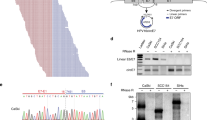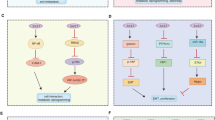Abstract
Studies on human papillomavirus type 16 have demonstrated that the product of the early gene, E7, plays a key role in the immortalization and malignant transformation of the host cell. Several of the biological activities of HPV16 E7 are mediated by inactivation of the members of the pocket protein family, pRb, p107 and p130. In this study, we have characterized the in vitro properties of five E7 proteins from benign and malignant HPV types (10, 32, 48, 54, 77). We show that these E7 proteins associate with pRb and p107 with different efficiencies. All E7s increased the proliferative rate of immortalized rodent fibroblasts cultured in 10% calf serum containing medium. This property is completely independent of their ability to associate with the pocket proteins. Furthermore, all E7s, except HPV10 E7, stimulate G1/S progression and activated the cyclin E and cyclin A promoter in the absence of growth factors. This activity also does not correlate with the E7-efficiency of binding the pocket proteins. Together these data provide evidence that different E7s alter the regulation of the cell cycle by diverse mechanism(s). Finally, this comparative analysis of the different E7 proteins demonstrates that the oncogenicity of a HPV type is not determined by the ability of E7 to associate with the pocket proteins.
This is a preview of subscription content, access via your institution
Access options
Subscribe to this journal
Receive 50 print issues and online access
$259.00 per year
only $5.18 per issue
Buy this article
- Purchase on Springer Link
- Instant access to full article PDF
Prices may be subject to local taxes which are calculated during checkout







Similar content being viewed by others
References
Banks L, Edmonds C and Vousden KH. . 1990 Oncogene 5: 1383–1389.
Beaudenon S, Kremsdorf D, Croissant O, Jablonska S, Wain-Hobson S and Orth G. . 1986 Nature 321: 246–249.
Botz J, Zerfass-Thome K, Spitkovsky D, Delius H, Vogt B, Eilers M, Hatzigeorgiou A and Jansen-Dürr P. . 1996 Mol. Cell. Biol. 16: 3401–3409.
Ciccolini F, Di Pasquale G, Carlotti F, Crawford L and Tommasino M. . 1994 Oncogene 9: 2342–2348.
Clemens KE, Brent R, Gyuris J and Munger K. . 1995 Virology 214: 289–293.
Dalton S and Treisman R. . 1992 Cell 68: 597–612.
Davies R, Hicks R, Crook T, Morris J and Vousden K. . 1993 J. Virol. 67: 2521–2528.
Delius H, Saegling B, Bergmann K, Shamanin V and de Villiers EM. . 1998 Virology 240: 359–365.
de Villiers E. . 1989 J. Virol. 63: 4898–4903.
de Villiers E. . 1997 Clin. Dermatol. 15: 199–206.
Durst M, Gissmann L, Ikenberg H and zur Hausen H. . 1983 Proc. Natl. Acad. Sci. USA 80: 3812–3815.
Dyson N, Howley PM, Munger K and Harlow E. . 1989 Science 243: 934–937.
Hu TH, Ferril SC, Snider AM and Barbosa MS. . 1995 Int. J. Oncol. 6: 167–174.
Jansen-Dürr P. . 1996 Trends Genet. 12: 270–275.
Kremsdorf D, Jablonska S, Favre M and Orth G. . 1983 J. Virol. Nov. 48: 340–351.
Lavia P and Jansen-Dürr P. . 1999 Bioessays 21: 221–230.
Mansur CP and Androphy EJ. . 1993 Biochim. Biophys. Acta 1155: 323–345.
McIntyre MC, Frattini MG, Grossman SR and Laimins LA. . 1993 J. Virol. 67: 3142–3150.
Morgenstern JP and Land H. . 1990 Nucleic Acids Res. 18: 3587–3596.
Muller M, Kelly G, Fiedler M and Gissmann L. . 1989 J. Virol. 63: 4907–4908.
Orth G, Jablonska S, Favre M, Croissant O, Jarzabek-Chorzelska M and Rzesa G. . 1978 Proc. Natl. Acad. Sci. USA 75: 1537–1541.
Pear WS, Nolan GP, Scott ML and Baltimore D. . 1993 Proc. Natl. Acad. Sci. USA 90: 8392–8396.
Phelps WC, Münger K, Yee CL, Barnes JA and Howley PM. . 1992 J. Virol. 66: 2418–2427.
Schmitt A, Harry JB, Rapp B, Wettstein OF and Iftner T. . 1994 J. Virol. 68: 7051–7059.
Schulze A, Zerfaß K, Spitkovsky D, Berges J, Middendorp S, Jansen-Dürr P and Henglein B. . 1995 Proc. Natl. Acad. Sci. USA 92: 11264–11268.
Seedorf K, Krammer G, Durst M, Suhai S and Rowekamp WG. . 1985 Virology 145: 181–185.
Shamanin V, zur Hausen H, Lavergne D, Proby CM, Leigh IM, Neumann C, Hamm H, Goos M, Haustein UF, Jung EG, Plewig G, Wolff H and de Villiers EM. . 1996 Natl. Cancer. Inst. 88: 802–811.
Storey A, Thomas M, Kalita A, Harwood C, Gardiol D, Mantovani F, Breuer J, Leigh IM, Matlashewski G and Banks L. . 1998 Nature 393: 229–234.
Tommasino M and Crawford L. . 1995 Bioessays 17: 509–518.
Tommasino M. (ed.) . 1997 Papillomaviruses in Human Cancer: The Role of E6 and E7 Oncoproteins RG Landes Co: Austin, Texas, USA.
Watanabe S, Sato H, Furuno A and Yoshiike K. . 1992 Virology 190: 872–875.
Wu EW, Clemens KE, Heck DV and Munger K. . 1993 J. Virol. 67: 2402–2407.
Zerfass K, Schulze A, Spitkovsky D, Friedman V, Henglein B and Jansen-Dürr P. . 1995 J. Virol. 69: 6389–6399.
zur Hausen H. . 1991 Science 254: 1167–1173.
zur, Hausen H. . 1996 Biochim. Biophys. Acta 1288: F55–F78.
Acknowledgements
We express our gratitude to Professor Harald zur Hausen for his constant support during the course of this work. We would like to thank all the members of our laboratory for their co-operation, Dr Pidder Jansen-Dürr for the plasmids containing cyclin E and A promoters and Dr Leonie Ringrose for her constructive comments on the manuscript. SC was supported by a PRAXIS XXI doctoral fellowship (Sub Programa Ciencia e Tecnologia do 2° Quadro Comunitario de Apoio).
Author information
Authors and Affiliations
Rights and permissions
About this article
Cite this article
Caldeira, S., de Villiers, EM. & Tommasino, M. Human papillomavirus E7 proteins stimulate proliferation independently of their ability to associate with retinoblastoma protein. Oncogene 19, 821–826 (2000). https://doi.org/10.1038/sj.onc.1203375
Received:
Revised:
Accepted:
Published:
Issue Date:
DOI: https://doi.org/10.1038/sj.onc.1203375
Keywords
This article is cited by
-
Human papillomavirus E7 induces p63 expression to modulate DNA damage response
Cell Death & Disease (2018)
-
HPV 16E7 and 48E7 proteins use different mechanisms to target p130 to overcome cell cycle block
Virology Journal (2016)
-
A functional interaction of E7 with B-Myb-MuvB complex promotes acute cooperative transcriptional activation of both S- and M-phase genes. (129 c)
Oncogene (2014)
-
Retinoblastoma-independent antiproliferative activity of novel intracellular antibodies against the E7 oncoprotein in HPV 16-positive cells
BMC Cancer (2011)
-
Human Papilloma Virus (HPV) and Host Cellular Interactions
Pathology & Oncology Research (2008)



